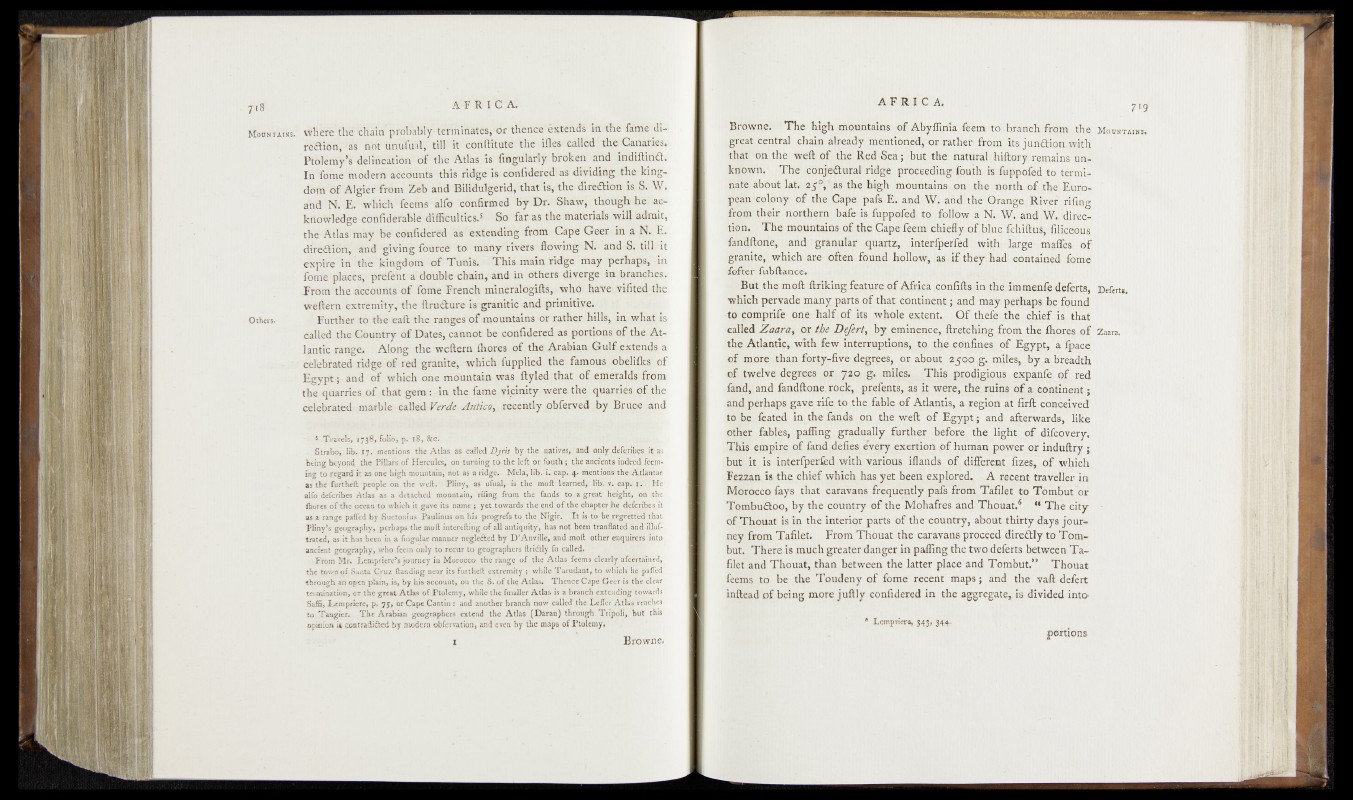
f l
Mountains
Others.
where the chain'probably terminated,'dr thence 'extends fcvthe fa^eip
re'aidn, as nbt unufual, till it edfiftithte the ifles called the Canaries.
Ptcidiitpd dfelmeatibn bf' th e AtlaS is Angularly broken and .indiftfotf.
In tome modern accounts this ridge is confidered as dividing'the kingdom
of Algief from Zeb and Bilidulgerid, that is, the direction is/S.'W.
and N. E. which feetairalfo confirmed By Dr; Shaw, though he'*c-
fcfid#ledge^cddfideraMe difficulties.5 So far as the materials willadfiit,
the Atlas may be confidered as extending from Cape Geer in & N i .
dtr^Stdh, and giving fource to many rivets flowing' N. and S. till it
expire in the kingdom of Tunis. This main ridge may perhaps,^in
fome places, prefent a double chain, and in others diverge in branches.
-From the accounts of fome French mineralogifts, who- have yifited^he
weftern extremity, the ftru&ure is granitic and primitive.
Further to the eaft the ranges of mountains or father hills, in whcyt- is
called the Country of Dates, cannot be confidered as portions; ofthe-Atlantic
range. Along the weftern Chores of the Arabian Gu'lfejsCends a
celebrated ridge of red granite, which fupplied the famous obelifbs1*- of
Egypt ; and of which one mountain was ftyled that ofLemeralds'frpm
the quarries of ^that gem: in the fanse vicinity were, the qu^r^s.qf £he
celebrated: marble called Verde Antico, recently obferved by Iffuce and
5 Travels, 1738, folio, p. 18, See.
Strabo, lib. 17. mentions the Atlas as called Dyris by'the natives, and only deferities it aa
being beyond the Pillars of Hercules, on turning to-the left or, fouth; the ancients indeed Teeming
to regard it as one high mountain, not as a ridge. Mela, lib. i. cap. 4: mentions the Atlantac
as the furtheft people on the weft. Pliny, as ufual, is the-moft/learned* lib.v. cap. ji;;|IiJe
alfo deferibes Atlas as a detached mountain, riling from the fands to a great height, on the
(bores of "the ocean to which it gave its name ; yet towards the end of the chapter he: deferibes. it
as a range pafled by Suetonius Paulinus on his progrefs to the Nigir. It is to be regretted that
Pliny's geography, perhaps the moft interefting of all antiquity, has not been tranflated and illuf-
trated, as it has been in a lingular manner neglefted by D ’Anville, and moft other enquirers into
ancient geography, who feero only to recur to geographers ftrictly fo called.
From Mr. Lempriere’s journey in Morocco the range of the Atlas feems clearly afeertamed,
the town of Santa Cruz Handing near its furtheft extremity; while Taruidaiit, to which tic pafled
through an open plain, is, by his account, on the S. of the Atlas. Thence Cape Geer is the clear
termination, or the great Atlas of Ptolemy, while the fmaller Atlas is a branch extending towards
Safi, Tempriere, p. 75, or Cape Cantin : and another branch now called the Teller Atlas reaches
to Tangier. The Arabian geographers extend the Atlas (Daran) through Tripoli, but this
opinion is contradicted by modern obfervation, and even by the maps of Ptolemy.
Browne.
Bi®wue.- The high mountains '©^A'by^ffiniai,le6{ij( to''bf!aneh<from 'the<'Mountain?.
gS&at central chain ;alre^;d^teendoEipd,t^ri rather ifroihj i||ijund:d4ti-W.6h
than dh the weft df?tt>be;Red!'S,ea; bjlt'*the natural'jhMoEycrerkaxns^bri-
knbwiv TheK:CQnje£tura|tri|^l„ .prodeediniMfibh K-fiafeoifed to^pani- ' ®
nate.'about lat;t:2^fi‘ as;t4 eihig.h>rinpuh^ti£isAdni..'the .tWhh r
pea|vdolpny of tfffe Cape pap.sM}^Ei.^.- ah'd'the .GfaHpjg© Rwer fifing
from their, northern bafe aLfuppofodi, tpi* follow apM»wLand |Wlillree^'
tion. _ The mountains'.offthe Cape.feem Ghiefi-^'^fi|)l^|£^fftul;||i|4hpu$
fandftone*, ; and T granular quartz, -interfperfed with large;»tnjg®gs. of
granite,I Which ate? often found hollow, iffthey;hadheqntained feme
fofter fubftahee.. 1
But the moft ftriking feature of'Africa^confifts-i-n jthe immqnfejffeferts, j^rti.
which pervade many.parts of that'Cpntipfe|it; and mjiy perhaps ,l>e found
to comp rife one half, (of its, whole «hstent», Qlimefe; jhe Ichief.'is, that
called Z a a r a , or the D e fe rti by eminence, ftretcl|%g from the ftioxes’ of v.*,™ ?
the Atlantic, with few interruptions, to .the confines of Egypt, d-:fg>§pp
of more than forjy-fivo,degrees, or about by;Mbl~4adth
of twelve degrees, t or 720 g., miles. This, prodigious expanfe df-red
fand, and fandftonevrock, prefents, as it were, the„ruins of » qoptinent;
and’perhaps gave rife Te the, fable of Atlantis, a region at firft ppmeeived
to be feated in the fands on the weft of Egypt; and afterwards, like
Other fables, paffing gradually further .before the,light,of djfcOvery.
This empire of fand defies every exertion pfhuman poweroripduftry;
but it ,, isH interfperfed with-ya^rioiis iflands of different fizes,, of which
Fezzan is the chi,ef which has yet been explored., A recent traveller in
Morocco fays that caravans frequently pats from Tafilet to TomButltl 1
Tombu&oo, by the country of the Mohafres and'Thoua't/ “ The city -
of Thouat is in the interior parts of the country, about thirty days jour?-
ney from Tafilet. From Thouat the caravans proceed dire&ly tffTom-
but.' There is much greater danger in paffing the two deferts between Taffies
and Thouat, than between the latter place and Tombut.” Thouat
feems to be the Toudeny of fome recent maps; and the vaft deffrt
inftead of being more juftly confidered in the aggregate,. is divided into*.
® Lempriers, 343, 344.
portions